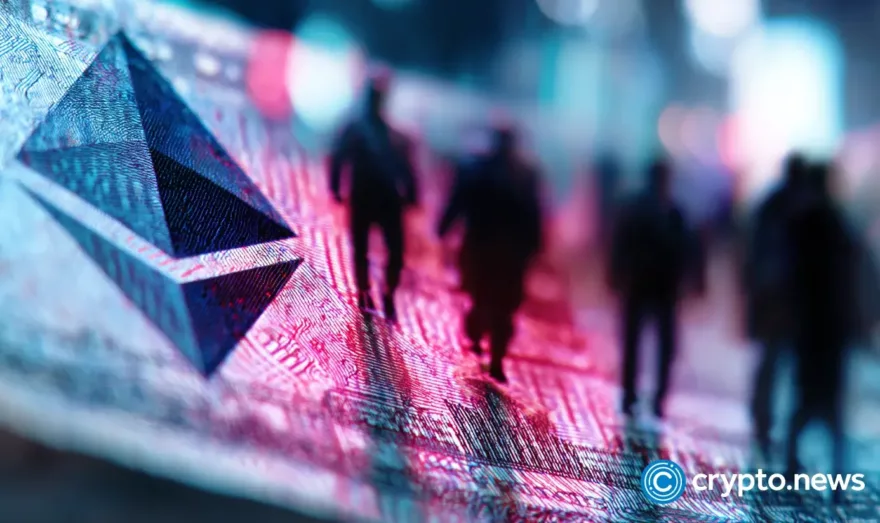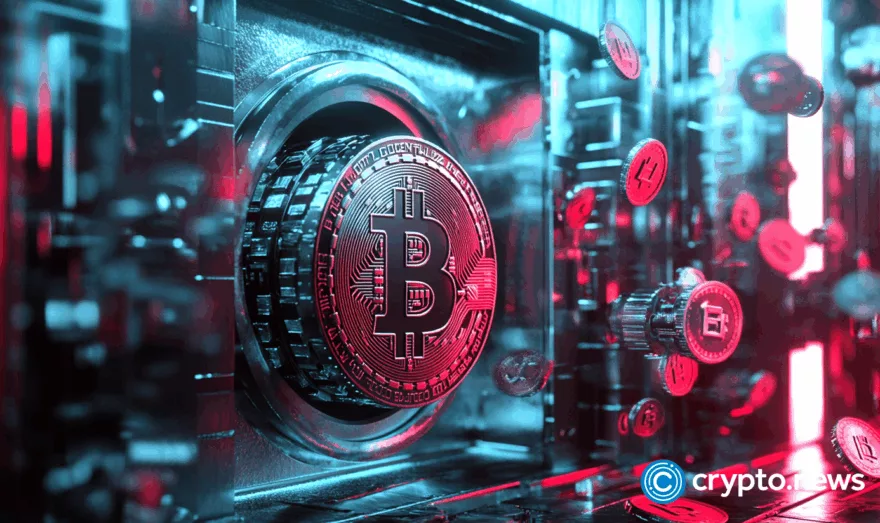Exclusive: co-founder Friederike Ernst on building Gnosis and bringing cypherpunk ideals to real life

In an exclusive interview with crypto.news, Friederike Ernst, co-founder of Gnosis, discusses the future of money and how the cypherpunk movement continues to impact crypto innovation.
In the bustling crypto landscape, Friederike Ernst, co-founder of Gnosis, has carved out a unique space for herself. A retired physicist with a penchant for building and cryptography, Ernst’s journey from academia to co-founding one of the most widely used decentralized payment platforms is a testament to her innovative spirit.
Ernst’s fascination with cryptography began in childhood, sparked by a book gifted by her father: The Code Book (1999) by Simon Singh. “I was the 12-year-old kid who set up her own PGP server,” Ernst recounts. “No one else was using it, but I had a good time.”
After completing her studies in physics and neuroscience in London and Berlin, Ernst embarked on a career in academia, conducting postdoctoral research at Columbia and Stanford before becoming a professor in Hamburg. It was in 2017 that Ernst decided to leave academia and co-found Gnosis, alongside the onchain wallet’s original co-founders Martin Köppelmann and Stefan George.
Initially incubated within ConsenSys as a prediction market, Gnosis Pay and later Gnosis Safe emerged as a foundational pillar of Ethereum’s ecosystem. “We started with the goal of building a prediction market platform,” says Ernst. “Our conditional token framework […] became the backbone for projects like Polymarket.”
Seeing the prediction market landscape as more daunting than the payment vertical, Gnosis eventually expanded its portfolio, creating tools and infrastructure critical to Web3. Gnosis Safe, the largest non-custodial smart wallet today manages over $100 billion in assets, while CowSwap, a decentralized exchange aggregator that matches buy and sell orders directly between users, is used by large and small investors alike to reduce fees and slippages.
All of this is technology is led by creating safe guardrails for capital flow, the veritable architecture of crypto capital, of which Ernst has spent a considerable part of the last decade years thinking about.
In recent years, Gnosis has focused on making blockchain technology more accessible to everyday users. Gnosis Pay, launched as a blockchain-native payment solution, integratea on-chain assets with real-world financial systems.
In April of this year, Gnosis Chain hit over 200 million transactions, a milestone that also saw Gnosis record over 55% growth in transactions year-on-year.
“One of the reasons we chose payments as a vertical is its simplicity compared to other sectors,” Ernst explained. “Payments are about balances that change according to well-understood rules.”
Gnosis Pay integrates with existing financial rails such as SEPA and VISA, enabling users to spend cryptocurrencies in traditional settings. “If you walk into Aldi and say you only have USDC, they’re not going to accept it,” says Ernst. “Our goal is to make on-chain assets compatible with real-world situations.”
Gnosis Pay works by taking a self custodial approach to wallets, allowing for EUR on the Gnosis Pay network that works as bridge between off chain visa transactions and on chain transactions on Gnosis Chain.
However, Ernst also underscored the importance of user experience, criticizing the traditional crypto onboarding process as overly complex. “The 24-word seed phrase is terrible UX,” she asserts. “We’re leveraging cryptographic advancements like biometric logins and social recovery to make crypto as intuitive as PayPal or Gmail.”
In addition, Gnosis Safe, launched in 2017, has become an indispensable tool for managing digital assets securely. Unlike traditional wallets, Gnosis Safe offers multi-signature functionality, allowing multiple parties to approve transactions.
“Gnosis Safe is more than just a wallet; it’s a digital vault,” says Ernst. “It’s used by DAOs, institutions, and individuals who prioritize security and transparenc,” Multisig has become an indispensable tool for ensuring cryptographic safety. With integrations into decentralized finance (DeFi) and NFT ecosystems, Gnosis Safe has become a cornerstone of trust in Web3, safeguarding billions in value.
Building a more equitable money supply
Yet one of the developments Ernst is most excited about is Circles, another Gnosis initiative, which aims to reimagine the distribution of Universal Basic Income, or UBI.
“One of the major drawbacks of the dollar system,” Ernst added, is that most of the global economy happens in US dollars. But then, even in the best of times, the Fed optimizes the dollar for it‘s 350 million subjects.”
That realization led to Circles, Ernst said, which seeks to empower users to control their own economic destiny. Launched in October 2020, Circles sparked a surge in grassroots adoption, with thousands across Europe forming trust connections through the network.
In Berlin, Cafe Grundeinkommen accepted CRC for morning coffee, while farmers’ markets embraced Circles for weekly trade. An experiment in Bali where thousands used the system also worked well, but there were bugs. Circles faced challenges all too common among early technologies: transaction demands, group and community connections required improvement, and users needed simpler ways to integrate Circles with existing payment systems.
In November, Circles 2.0 was launched at DevCon in Bangkok. Operating on Gnosis Chain, Circles 2.0 enables users to issue and exchange personalized currencies with their social network, adding features that will help Circles scale in users, groups and communities.
“The idea is to create a grassroots financial system,” Ernst explains. “Circles emphasize trust and community, making UBI more sustainable and scalable.”
By allowing for the creation of personal and group avatars and their currencies through the CRC token. Circles then deploys what it calls a pathfinder to find and locate the optimal path between trust connections, thereby concluding the transaction.
Circles uses smart contracts based on ERC20 and ERC1155 multi-token standards for both personal avatars and group avatars, but it’s a system Ernst sees as empowering the next generation of economic actors to take economic agency.
In the Circles ecosystem, a person receives 1 CRC every hour, with 24 CRC being given out in a single day. Circles undergo daily demurrage at a rate equivalent to 7% per year, and issuance for past days accounts for this demurrage, which Ernst says creates a fairer distribution over time.


A flow of architecture for Circles 2.0 Protocol. Source: Gnosis
“We call it the leaky memory effect,” Ernst said. “For example, things you did last week should count a lot, but things that your ancestors did 200 years ago, they should count for a lot less.” This means that within the Circles economy, “people who come later are still incentivized to join because old money gets deflated over time.”
It’s an innovation that aims to empower local communities to launch complementary currencies, including organizations who may want to build internal economies, as members of a group can now mint a shared currency by locking their personal CRC as collateral in a group vault. Known as Group Circles, fungible and tradeable within the group, these can later be redeemed for any CRC in the vault, maintaining a stable supply while fostering community-driven economies.
“Circles is a decentralized web of trust because you are immediately incentivized to remove all your untrustworthy connections, otherwise, they could stick you with their worthless Circles,” Ernst suggests.
It is this vision of a more decentralized, autonomous, and economically equitable society that drives Ernst’s relentless dedication towards her ideas of what money is, and what it can be. An idea that is also increasingly within the crosshairs of European regulators, be it France’s recent decision to potentially tax unrealized Bitcoin gains, or the ongoing legal woes of Tornado Cash, the new frontiers of the economics of exchange remains in flux.
MiCA and the regulatory climate
Regarding the current regulatory climate in Europe, Ernst is candid about the hurdles facing the crypto industry, particularly in Europe under the Markets in Crypto-Assets Regulation (MiCA). “Regulators are inherently risk-averse, aiming to prevent crises,” she observes. “But this approach often stifles innovation, leaving Europe at a disadvantage.”
As such, Ernst advocates for a balanced approach to regulation, one that fosters innovation while addressing risks. “Technologies with disruptive potential, like AI and blockchain, require nuanced oversight,” Ernst argues. “Banning or over-regulating them only drives development elsewhere.”
Looking ahead, Ernst envisions a future where decentralized technologies seamlessly integrate with everyday life. “We need to bring real value and real people into the ecosystem,” she says. “This means bridging the gap between on-chain and off-chain assets.”
Staying true to the core tenets of decentralization: shared ownership, individual agency, and permissionless innovation, Ernst still sees a lot of room for innovation and growth.
“I think the cypherpunk movement has always been about restoring agency to individuals,” Ernst concluded. “We’ve built the pipes; now it’s time to put the drywall on.”














